Navigating the world of skincare can feel like finding your way through a maze. On a global scale, the world of beauty is relatively unregulated and unstandardized. We aren’t saying this to scare you! We want to give you some tools and tips so you can read ingredients lists like a pro. ☺️
This article will cover everything you need to know about reading an ingredient list for skincare:
- Understanding ingredient names
- Why the order of an ingredients list matters
- What are active ingredients?
- Drawbacks to reading ingredient lists
- Regulations for skincare labels

Ingredient Names
INCI Name
You might notice some ingredient names are long and hard to pronounce. You might even get flashbacks to chemistry class!
This is because most labels use INCI names. INCI stands for International Nomenclature Cosmetic Ingredient.
INCI is a global system of naming ingredients. The International Nomenclature Committee (INC) oversees and regulates these names. These names are based on the Latin and scientific names of ingredients. Thus, research papers will refer to ingredients by their INCI name.
Please note, INCI names differ from the chemical names. The chemical names are set by the nomenclature based on chemical structure.
Common Name
Besides INCI names, labels will also use ‘common’ names. These are names we would more likely use when talking with a friend. One example is using “Vitamin C” instead of “Ascorbic Acid”.
Another example would be saying “Green tea” instead of “Camellia Sinensis Leaf Extract”. Using the common names for ingredients is easy but can have limitations.
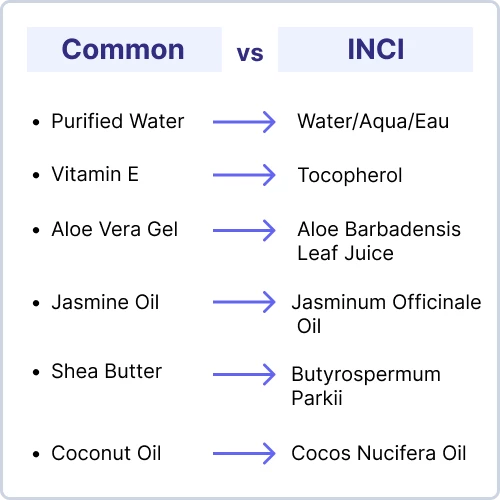
Using a common name when referring to an ingredient can cause some issues. Many common names don’t give us enough specifics about the ingredient.
For instance, an ingredient going by “seaweed extract” can be from hundreds of kinds of seaweed. Each seaweed might have different skin benefits depending on their composition.
One type of seaweed might have more Vitamin C, while another may have stronger antioxidant activity. While seaweed is generally a great skincare ingredient with few concerns, other ingredients may not be.
Manufacturer Name
Another naming convention to look out for is the use of manufacturer names. These are trademarked names given to ingredients by manufacturers. Like common names, manufacturer names can cause some limitations.
Manufacturer names are often proprietary blends of many ingredients. This can lead to a misleading label. Extra research is needed to understand what ingredients are part of the blend.
One example of a manufacturer ingredient is OliveM 1000. This ingredient has two INCI names listed: Cetearyl Olivate and Sorbitan Olivate.
An ingredients list using INCI names will usually give the most accurate picture.
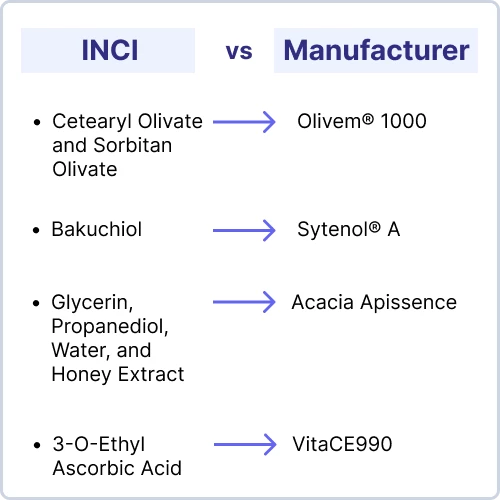
Order of Ingredients List
The order of your ingredients list paints a big picture of the product.
Both the FDA and the EU Cosmetics Regulation requires ingredients to be ordered from largest weight to smallest. This means the ingredients with the highest percentage in a product are at the top of the list.
A common ingredient near the top of a list is water: this just means water makes up a large portion of the product.
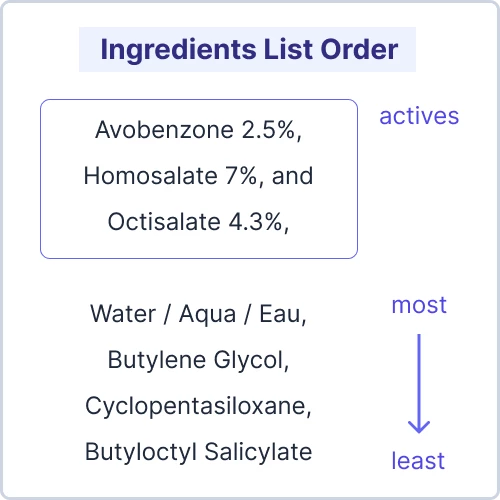
Active Ingredients
Active ingredients, also known as drug ingredients, are also required to be at the top of the list.
Active ingredients are defined as: an ingredient that provides a diagnosis, cure, mitigation, treatment, or prevention of any function.
Some examples of active ingredients in skincare include: retinol, AHAs, BHAs, sunscreen ingredients, Vitamin C.
Bottom of Ingredients List
One thing to note is the bottom of the list. Ingredients that make up less than 1% of the product and color additives are not required to be in any order. Once we get to these ingredients, they no longer have to be in descending order.
Drawbacks
Ingredients lists, as helpful as they are, can have some limitations. There are many things we cannot know for certain.
Drawback #1
The biggest limitation is understanding how effective an ingredient will be. Certain ingredients work in larger concentrations.
While we can guess the percentages of certain products, it is impossible to know for certain. The only way to know is if a company discloses this information. The general rule of thumb is ingredients near the top of ingredients lists have more of an impact
Drawback #2
Another limitation is understanding the source of ingredients. Some ingredients are only effective based on the source.
Rosehip oil should be a beautiful orange color. Think the red-orange autumn leaves! This color indicates high amounts of essential fatty acids and beta-carotene. Having high amounts of fatty acids and beta-carotene is great for moisturizing skin.
Other ingredients might be contaminated during creation. While most contaminations are not harmful, they can make the ingredient ineffective. Ingredients might also be sourced unethically (such as mica mined using child labor).
The source of an ingredient is only known if disclosed by the company.
Drawback #3
Using common names creates some limitations to our understanding as well.
This is especially true for plant extracts. As you know, plants have many parts to them: stem, leaves, roots, fruit. Most of the time, the different parts of the plant have different benefits. Unless a common name specifies which part of the plant the extract is from, we may never know.
Here is an example using the ingredient Lemon:
- Less accurate: Citrus Limon Peel
- More accurate: Citrus Limon Peel Oil
Drawback #4
The last limitation is labeling error. Many labels might be missing ingredients or have misspellings for similar ingredients (squalane vs squalene).
One study from 2020 found around ⅓ of the products studied had missing ingredients in the lists.
Drawback #5
There are many loopholes in ingredients lists as well, such as with the term fragrance/parfum.
To give you a short summary, 'parfum' can be a blend of up to hundreds of other fragrances! Most of the time, 'parfum' is a proprietary blend and unknown to consumers.
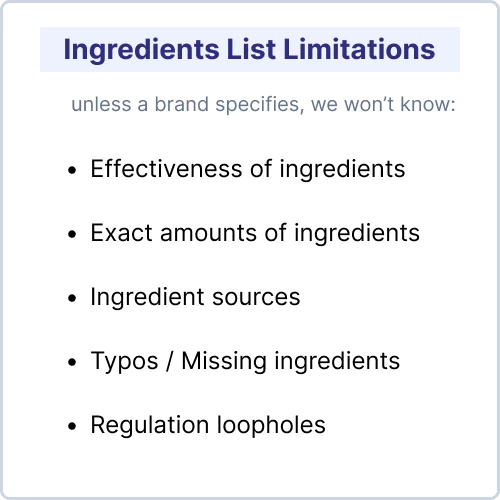
Regulations by Country
SkinSort contains products from all over the world. Unfortunately, covering every country will lead to a wordy article. Here are some resources for you to find the regulations of a specific country.
The EU
Canada
India
Australia
South Korea
We recommend checking out your country’s governmental health department for cosmetics regulations.
Cosmetic Labels
If you need a rundown of labeling on cosmetics (such as understanding unscented vs fragrance-free), check out our guide here. We also cover the differences between natural and organic skincare.
How SkinSort Helps
SkinSort’s ingredient analyzer can help you scan an ingredients list quickly. You can copy+paste in an ingredients list, or upload a photo!
Pro Tip: When you make an account, you can also set your liked/disliked ingredients. Setting these ingredients can help you see if a product contains these ingredients at a glance.
This can help you avoid the ingredients you don’t like, and find the ones you do like more easily.
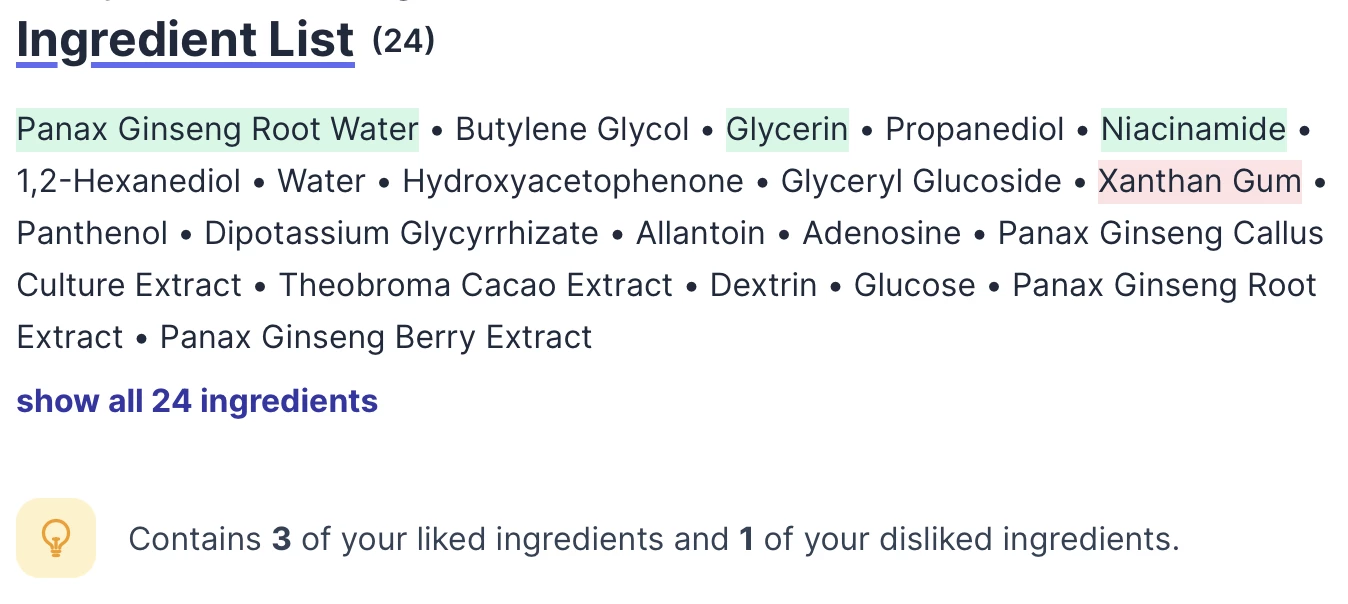
Start Analyzing Ingredients Lists 👉
Now you're all equipped to navigate the world of ingredients lists. We can't wait to see the amazing products you'll find! 😊